Pachypodium bicolor is a species of plant in the family Apocynaceae.
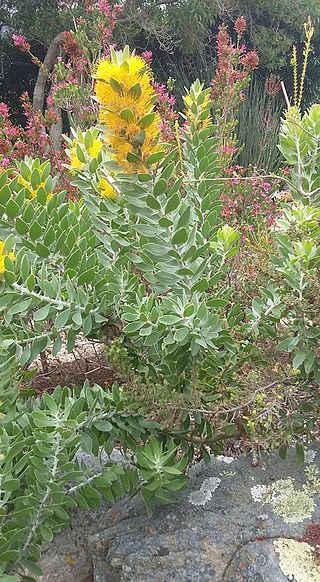
Mimetes chrysanthus is an evergreen, upright shrub of 1½–2 m high that has been assigned to the family Proteaceae. It has green, slightly stalked oval leaves of 3–4½ cm (1.2–1.8 in) long and 1–1¾ cm (0.4–0.7 in) wide. The inflorescences are near the tip of the branches, cylinder-shaped and consist of 50–70 densely cropped flower heads, each in the axil of a green leaf, consisting of 25–35 golden yellow, faintly sweet scented flowers. It is endemic to the Fynbos ecoregion of South Africa and is found in two locations, in the Western Cape province. The flowering season is from March to May or June, but flower heads sometimes occur in any other part of the year.
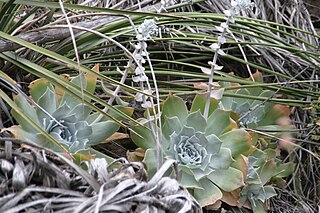
Dudleya pulverulenta is a species of perennial succulent plant known by the common names chalk lettuce, chalk dudleya, and chalk liveforever. It is one of the largest Dudleya, with a silvery, waxy rosette that may greatly contrast with its habitat. It is also regarded as one of the most distinctive members of the Dudleya, with the most advanced inflorescence in the genus, consisting of pendant, hummingbird pollinated flowers, the longest corolla, and the highest nectar output, along with the largest range of all the Dudleya, over 1,000 kilometres (620 mi), being found from southern Monterey County in California to the Sierra de San Borja in southern Baja California.

Potamogeton natans, commonly known as broad-leaved pondweed, floating pondweed, or floating-leaf pondweed, is an aquatic species in the genus Potamogeton native to quiet or slow-flowing freshwater habitats throughout the Holarctic Kingdom.
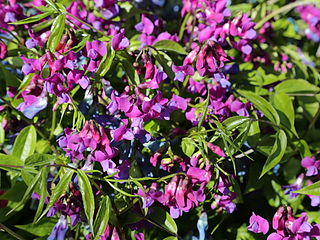
Lathyrus vernus, the spring vetchling, spring pea, or spring vetch, is a species of flowering herbaceous perennial plant in the genus Lathyrus, native to forests of Europe and Siberia. It forms a dense clump of pointed leaves with purple flowers in spring, shading to a greenish-blue with age.

Puya alpestris is a species of bromeliad native to Chilean Andes. It is native to dry hills, rock outcrops in central and southern Chile at elevations of 0 to 2200 meters. It is one of the most southerly occurring species within the family. Puya alpestris is one of the few Puya species that are grown in some parks and gardens as an ornamental plant.
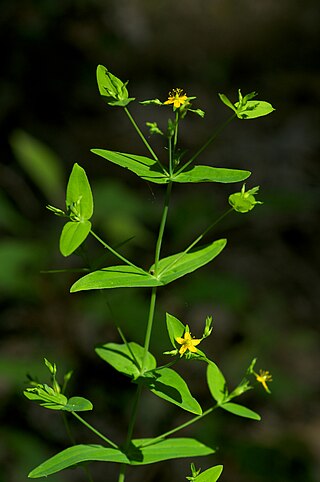
Hypericum mutilum is a species of St. John's wort known by the common name dwarf St. John's wort. It is native to parts of North America and is present in other parts as an introduced species. It is an annual or perennial herb taking a multibranched erect form up to about 60 centimeters tall. The oval green leaves are one or two centimeters long and are covered in tiny glands. The inflorescence is a compound cyme of tiny flowers. H. mutilum subsp. mutilum and subsp. boreale have a diploid number of 16, and H. mutilum subsp. boreale can have a diploid number of 18.

Potamogeton obtusifolius, known as blunt-leaved pondweed, is an aquatic plant in the genus Potamogeton. It grows mainly in mesotrophic to eutrophic lakes, ponds and ditches, rarely in brackish water. It occurs primarily in Central Europe, the British Isles, Fennoscandia and eastern North America.
Potamogeton × griffithii is a hybrid pondweed between Potamogeton alpinus and Potamogeton praelongus. It occurs in oligotrophic, moderate alkalinity lakes.

Potamogeton × angustifolius is a hybrid pondweed between Potamogeton gramineus and Potamogeton lucens, known as long-leaved pondweed. It is widespread in rivers and lakes except where the water is very soft.

Mimetes splendidus or splendid pagoda is an evergreen, rather sparsely branching, upright shrub of up to 2½ m (8 ft) high from the family Proteaceae. It has broadly lance-shaped to oval, silvery-hairy leaves with three or four teeth crowded at the tip. It has cylinder-shaped inflorescences that consists of many heads, each containing eleven to thirteen flowers, in the axils of the highest leaves. These leaves form a hood over a lower flowerhead and are flushed orangy pink. It flowers during winter, from early May to September. It is an endemic species that is restricted to the south face of the coastal mountains of the Western Cape province of South Africa.

Mimetes pauciflorus, the three-flowered pagoda, is an evergreen, shyly branching, upright shrub of 2–4 (6½–13 ft) high, from the family Proteaceae. It has narrowly to broadly oval leaves of 2½–4 cm (1.0–1.6 in) long and ¾–2 cm (0.3–0.8 in) wide, on the upper parts of the branches, the lower parts leafless with a reddish brown bark. The inflorescences at the top of the shoots are cylinder-shaped, 10–40 cm (4–16 in) long and contain forty to one hundred twenty densely crowded flower heads, at a steep upward angle, hiding a crest of very small, almost vertical leaves. The flower heads each consist of three, rarely four individual flowers. The flowers are tightly enclosed by four or five orange-yellow, fleshy, pointy, lance-shaped involucral bracts, and three orange-yellow, 4–5½ cm (1.6–2.4 in) long bracteoles. It grows on always moist, south-facing slopes in the southern coastal mountains of South Africa. Flowers can be found from August to November, with a peak in September.

Mimetes saxatilis or limestone pagoda is an evergreen, upright, rarely branching shrub of 1–2¼ m (3⅓–7¼ ft) high, assigned to the family Proteaceae. The approximately oval leaves are 3½–5 cm (1.4–2.0 in) long and 1½–3 cm (0.6–1.2 in) wide with a blunt, thickened, reddish tip or with three crowded teeth. It has cylinder-shaped inflorescences topped by a crest of green leaves, further consisting of heads with 12-22 individual bright yellow flowers, each in the axil of a flat, green leaf. It is an endemic species that is restricted to limestone outcrops in the Agulhas plains in the very south of the Western Cape province of South Africa. It is considered an endangered species. Flowering may occur between July and December, but is unreliable in its timing, dependent on sufficient moisture availability.

Prunus himalayana, called jyokun shin in Tibetan and 喜马拉雅臭樱 in Chinese, is a species of Prunus native to Nepal, Bhutan, Sikkim and Tibet. It prefers to grow 2,800 to 4,200 m above sea level in the Himalayas. As Maddenia himalaica it was the type species for the now unrecognized genus Maddenia.
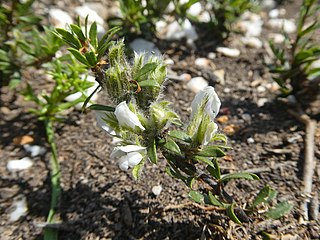
Otholobium curtisiae is a small spreading shrub assigned to the Pea family. All green parts are covered in hairs and urn-like glands. It has many woody stems, small and somewhat succulent, dark green alternately set clover-like leaves and heads consisting of 3-9 white, pea-like flowers on very short peduncles in the axils of the leaves. This species is an endemic of the Overberg area in the Western Cape province of South Africa. It mostly flowers in August and September.
Otholobium dreweae is an upright shrublet assigned to the Pea family of about 15 cm (5.9 in) high, that appears after the vegetation burned down from the underground rootstock and forms mat-like clumps of hardly branching, leafy stems. The stems are set with stiff, entire, alternate leaves with a single leaflet and heads consisting of 12-18 initially dark pink, later white, pea-like flowers with a white nectar guide on a peduncle as long as the leaves at the end of the stem. This species is an endemic of the Kleinrivier Mountains in the Western Cape province of South Africa. It mostly flowers in November.
Otholobium accrescens is an upright, largely herbaceous subshrub assigned to the Pea family. It has up to three stems that carry upright branches in leaf axils near the ground, and have alternately set inverted egg-shaped leaves and lax heads consisting of 12-21 pea-like flowers on long peduncles in the axils of the lower leaves. It differs from most other Otholobium species by the calyx that continues to grow after flowering and the leaf that consists of just one leaflet. It is an endemic of the Eastern Cape province of South Africa near Loerie. It probably flowers August to January.

Otholobium lanceolatum is a small subshrub of up to 20 cm (7.9 in) high, that is assigned to the Pea family. It has up to 7 horizontal stems with raised tips, few hairless, alternately set leaves with only one leaflet and clusters of 15-27 white, pea-like flowers with a purple tip near the top of the short, seasonal shoots. It is endemic to one site near Caledon, South Africa. Flowers only appear in November and December within one year after a fire destroyed the vegetation.
Zanthoxylum dissitum is a woody plant native to China. It grows in upland thickets and open forests, forests, at 300-2600 m altitude.
Stenanthemum liberum is a species of flowering plant in the family Rhamnaceae and is endemic to the southwest of Western Australia. It is a dwarf or prostrate shrub with densely hairy young stems, elliptic to egg-shaped with the narrower end towards the base, and densely hairy heads of tube-shaped flowers.














